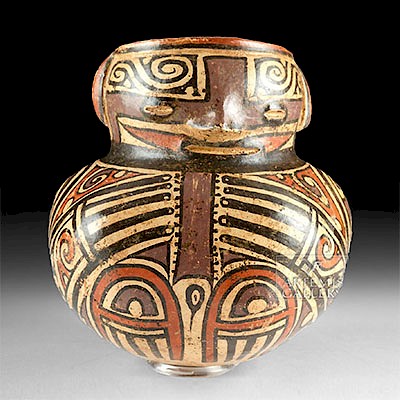Sassanian Glass Wheel Cut Bowl
Lot 39a
About Seller
Artemis Fine Arts
686 S Taylor Ave, Ste 106
Louisville, CO 80027
United States
Selling antiquities, ancient and ethnographic art online since 1993, Artemis Gallery specializes in Classical Antiquities (Egyptian, Greek, Roman, Near Eastern), Asian, Pre-Columbian, African / Tribal / Oceanographic art. Our extensive inventory includes pottery, stone, metal, wood, glass and textil...Read more
Estimate:
$800 - $1,200
Absentee vs Live bid
Two ways to bid:
- Leave a max absentee bid and the platform will bid on your behalf up to your maximum bid during the live auction.
- Bid live during the auction and your bids will be submitted real-time to the auctioneer.
Bid Increments
| Price | Bid Increment |
|---|---|
| $0 | $25 |
| $300 | $50 |
| $1,000 | $100 |
| $2,000 | $250 |
| $5,000 | $500 |
| $10,000 | $1,000 |
| $20,000 | $2,500 |
| $50,000 | $5,000 |
| $100,000 | $10,000 |
| $200,000 | $20,000 |
About Auction
By Artemis Fine Arts
Nov 8, 2018
Set Reminder
2018-11-08 10:00:00
2018-11-08 10:00:00
America/New_York
Bidsquare
Bidsquare : Ancient / Ethnographic From Around The World
https://www.bidsquare.com/auctions/artemis-gallery/ancient-ethnographic-from-around-the-world-3598
Ancient art from Egypt, Greece, Italy and the Near East, as well as Asian, Pre-Columbian, Native American, African / Tribal / Oceanic, Spanish Colonial, Russian Icons, Fine art, much more! Artemis Fine Arts info@artemisgallery.com
Ancient art from Egypt, Greece, Italy and the Near East, as well as Asian, Pre-Columbian, Native American, African / Tribal / Oceanic, Spanish Colonial, Russian Icons, Fine art, much more! Artemis Fine Arts info@artemisgallery.com
- Lot Description
Near East, Sassanian Empire, ca. 500 CE. A thick-walled ancient glass vessel, its surface cut with circular facets in a honeycomb pattern. This hemispherical bowl may have been made by blowing molten glass into an open mold ; subsequently, four rows of oblong-to-round facets were wheel-cut and polished around the body. The thick glass, probably originally pale green, has gained extensive deposits over time, creating a mottled grey and beige surface with dots of creamy white and black. Size: 3.6" W x 2.95" H (9.1 cm x 7.5 cm)
Faceted bowls such as this one are characterized by uniformity of shape, size, and arrangement of the facets in four or five rows. They represent the most widespread type of late Sassanian glass vessel, found in excavations of Mesopotamian and Iranian sites dating from the fifth to seventh century CE. Some examples - probably carried along the Silk Road to the Far East by Persian merchants and traveling embassies - have been found in Japanese contexts, namely in the sixth-century tomb of the emperor Ankan and in the Shoso-in Treasure at Nara, which was assembled by the emperor Shomu in the eighth century.
Provenance: private East Coast, USA collection
All items legal to buy/sell under U.S. Statute covering cultural patrimony Code 2600, CHAPTER 14, and are guaranteed to be as described or your money back.
A Certificate of Authenticity will accompany all winning bids.
We ship worldwide and handle all shipping in-house for your convenience.
#139631Repaired and restored, with some modern fill added, low on the body. Covered with a heavily encrusted, deposited surface. No pontil mark because the piece was mold-made rather than free blown.Condition
- Shipping Info
-
All shipping is handled in-house for your convenience. Your invoice from Artemis Gallery will include shipping calculation instructions. If in doubt, please inquire BEFORE bidding for estimated shipping costs for individual items.
-
- Buyer's Premium



 EUR
EUR CAD
CAD AUD
AUD GBP
GBP MXN
MXN HKD
HKD CNY
CNY MYR
MYR SEK
SEK SGD
SGD CHF
CHF THB
THB
















